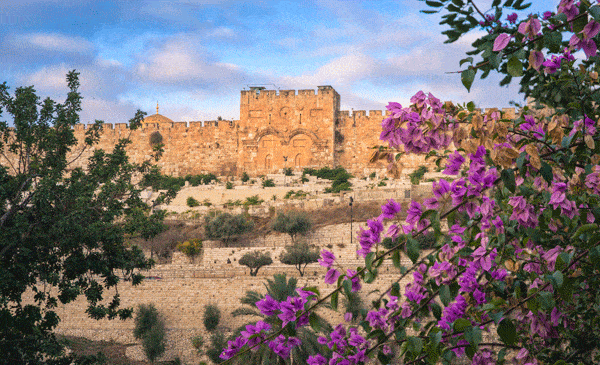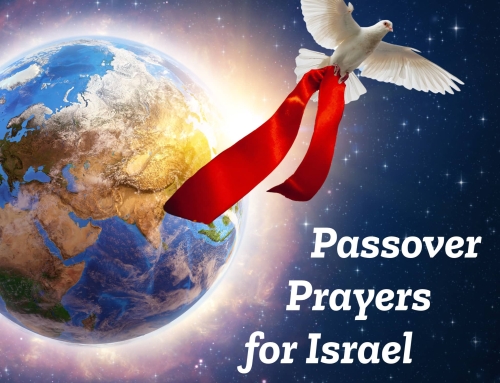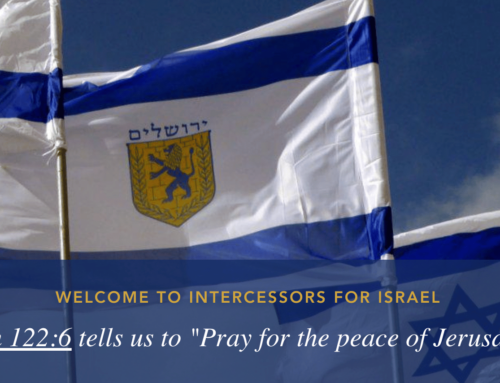By Christine Darg
Jerusalem Channel
The ancient gates of Jerusalem have stood guard over the Holy City for centuries.
Nehemiah Chapter 3 described his repair of the gates of Jerusalem in the 5th century BC. I believe these ancient gates represent a parable of the stations of the cross in a believer’s life. And for that reason the gates are a valuable object lesson.
First of all, what are these “stations of the cross?”

Pilgrims visiting Jerusalem are invited to walk “14 stations of the cross,” also called the Via Dolorosa, or the Way of Sorrows. This meditative walk through Jerusalem’s sacred Old City follows the last hours of Jesus and refers to his atoning Passion.

The lives of believers are also full of trials as we walk the path of life.
Here’s the correlation with Jerusalem’s ancient gates: Jesus told his followers that we would also carry our individualized, custom-made crosses throughout our lifetime.
A believer’s walk is one of self-sacrifice in the footsteps of our Lord.
That is why, when studying the book of Nehemiah, I was delighted to discover that the third chapter is a picture of the various stations of the Cross doing its work of sanctification in a believer’s life.

Here’s a little historical background: An exile in Persia, Nehemiah carried in his heart a concern for the welfare of his people and their capital Jerusalem. When Nehemiah heard a report of the deplorable state of Jerusalem, he was greatly disturbed. Jerusalem was in “great trouble and disgrace. The wall of Jerusalem was broken down, and its gates were burned with fire.” Nehemiah wept, fasted and repented. Then he received permission to return to Jerualem to rebuild the walls and gates of Jerusalem.

There are definite spiritual lesson in each of the “gate stations” that were restored:

The first gate to be repaired was called the Sheep Gate in Nehemiah Chapter 3: 1. The Sheep Gate speaks of the primary and foundational sacrifice at the altar of the Cross. Messiah dying as a substitutionary sacrifice for our sins is the foundation and beginning of our spiritual journey.
Interestingly, the Sheep Gate was the first gate to be repaired because without the blood sacrifice of the Lamb of God, there is no salvation. In Nehemiah 3: 1, when the Sheep Gate was consecrated, there was no mention of bolts, locks or bars although these are mentioned concerning the other gates. The door of salvation is always open and never bolted and barred to sinners.

The Sheep Gate is the only gate that was dedicated, or sanctified, thus setting it apart as a special gate. The Good Shepherd of our souls teaches us to enter by the narrow gate. “Go in through the narrow gate, because the gate is wide and the road is spacious that leads to destruction, and many people are entering by it.” (Matthew 7:13) The above art depicts the narrow gate of salvation from The Pilgrim’s Progress by John Bunyan.

The second gate that was repaired was called the Fish Gate (Nehemiah 3:3). In our spiritual walk this reminds us of the fact that we are called not just to salvation but to bring others to the Lord. The Fish Gate reminds us of the necessity of soul winning and fulfilling the Great Commission to go into all the world to preach the Gospel. Jesus said to his disciples in Mark 1:17, “Follow me and I will make you fishers of men.”

Jeremiah 6: 16 exhorts us to “stand at the crossroads and look; ask for the ancient paths, ask where the good way is, and walk in it, and you will find rest for your souls.” Thus the third gate was called the Old Gate in Nehemiah 3:6. This gate symbolizes the ancient paths and the eternal truths of the Word of God that bring peace, protection and safety when we walk in the Lord’s precepts and statues. The people of the world focus on the latest ideas (Acts 17:21), but basic truths such as the Ten Commandments bring health and order to society, restraining lawlessness and chaos.
The fourth gate was the Valley Gate (Nehemiah 3:13), an important picture of the believer’s descent into humility. Messiah, of course, is our example and best Teacher-Mentor because He descended from heavenly Glory into the valley of humiliations and death, even the death of a criminal. We prefer mountaintop experiences, but sometimes we have to descend to the depths to learn valuable lessons and to humble ourselves in the sight of God so that He may lift us up in due season. Nobody can become great in the Kingdom of God without going through the Valley Gate of humility.

The fifth gate that was repaired in Nehemiah Chapter 3: 13 – 14 was called the Dung Gate. This was the garbage gate through which the waste of the city was dumped. This gate speaks very clearly of purging our lives from sin and purifying our walk, the ongoing work of sanctification. In today’s Jerusalem the above photo is the Dung Gate.
Gate six was called the Fountain Gate in Nehemiah 3:15. The Fountain Gate speaks of sanctification and the ministry of the Holy Spirit in our lives.
Indeed, the order of these gates is notable: following salvation (Sheep Gate) and humility (Valley Gate) there is sanctification and cleansing (Dung Gate), followed by the filling of the Spirit (Fountain Gate). Out of our innermost being will flow living waters welling up to eternal life!

Gate seven in the above Internet screenshot was the Water Gate (Nehemiah 3:26). Note that seven is the Bible number for perfection – the perfect Word of God. Water speaks of the ordinance of baptism and also the daily cleansing of the believer by the Word of God: “Christ loved the church and gave himself up for her that he might sanctify and cleanse it with the washing of water by the word.” (Ephesians 5: 25-26)

My dear ministry partner Miss Florence of blessed memory (above photo) asked the Lord while she was washing dishes in our former ministry center in Gethsemane, “Lord, why do I clean these same dishes over and over day by day?” And He answered— for the same reason that we read the word daily: there is no other way to stay clean but to have the continual washing of the Word. “How can a young person stay on the path of purity? By living according to your word.” (Ps. 119:9).
Number 8, the Horse Gate (Nehemiah 3:28) represents the truth of spiritual warfare in our lives. Paul exhorts us to fight the good fight of faith. We must be trained like war horses to endure many arduous and long battles. Certainly there are many conflicts in a believer’s life, and we must be ready to persevere and not give up.

The ninth gate, the East Gate (Nehemiah 3.29) survives to this day. The Eastern Gate always makes us think of the Second Coming of Jesus, and for this great event we must always be watching and waiting! In Ezekiel 10:16-22, the prophet saw God’s glory depart from the temple through the East gate; but later he saw God’s glory return “from the way of the east.” (Ezekiel 43:1-5) Believers who cherish this hope purify themselves and live lives worthy of the Lord, occupying until He comes.
Finally, Gate number 10 in Nehemiah’s day was called the Miphkad Gate (King James Version), שער המפקד , or the Inspection Gate. The repair of this final gate is mentioned in Nehemiah 3: 31. The Inspection Gate speaks of God’s judgment. The Hebrew word for this gate means “appointment, account, census, mustering.” It carries the idea of troops showing up for review, or an appointed place for a meeting. “For we must all appear before the judgment seat of Christ, that each one may receive the things done in the body, according to what he has done, whether good or bad.” (2 Corinthians 5: 10)
As we have reviewed these gates around Jerusalem we have seen the major stations and appointments of the life of a believer from the Sheep Gate (salvation) to the Inspection Gate (final judgment). But praise God according to the New Testament, those who are safely in the ark of Messiah will never face damnation due to our sins. John 5:24 is the wonderful Gospel promise of our Lord: “Very truly I tell you, whoever hears my word and believes him who sent me has eternal life and will not be judged but has crossed over from death.”
Romans 8: 1-2 also promises, “There is therefore now no condemnation to them which are in Christ Jesus, who walk not after the flesh, but after the Spirit. For the law of the Spirit of life in Christ Jesus hath made me free from the law of sin and death.” Yeshua’s blood cleanses us and presents us righteous and worthy in the presence of a holy God. Oh, what a great salvation! Hallelu-Yah to the Lamb!

My gates analogy doesn’t follow through to match all 14 Stations of the Cross. . . perhaps I need to add four of the later gates in history: for example, the New Gate could represent the new birth; Herod’s Gate could stand for overcoming the Herods and Hamans of our life; Jaffa Gate, also called the Gate of the Friend Abraham, represents becoming the intimate friend of God; and finally, Zion Gate is symbolic of our ultimate dwelling place in the Heavenly Jerusalem: “But you have come to Mount Zion and to the city of the living God, the heavenly Jerusalem, and to myriads of angels. . . .”(Hebrews 12: 22) These additional gates represent our progress in our walk with God, growing in spiritual maturity.
To follow or support the work of Christine Darg, visit www.JerusalemChannel.tv/donate/






Leave A Comment